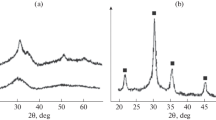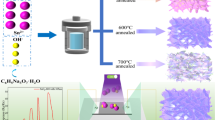Abstract
The influence of surface tension, interfacial reaction, and solid surface properties on the spontaneous infiltration of porous SnO2 by liquid silver was investigated. It was found that infiltration is enhanced with higher oxygen concentration in the atmosphere. The role of additives was exemplarily addressed by utilizing small amounts of either WO3 or CuO. Attendant interfacial reactions were studied by simultaneous DSC/TG measurements. Furthermore, XPS measurements revealed the strong influence of SnO2 particle surface properties on infiltration. A non-stoichiometric surface was found to enhance the infiltration, whereas a stoichiometric SnO2 surface completely prohibits the infiltration by liquid Ag. This was additionally proven by changing the SnO2 surface properties through adding WO3 or CuO. WO3 as an additive stabilizes the stoichiometric SnO2 surface, and in contrast to this, CuO induces Sn2+ states. Thereby, spontaneous infiltration is prevented by WO3 and enhanced through CuO doping. The SnO2 infiltration behavior is explained by the interfacial interactions between Ag and the SnO2 surface.







Similar content being viewed by others
References
Kaczmar JW, Pietrzak K, Wlosinski W (2000) The production and application of metal matrix composite materials. J Mater Process Technol 106(1–3):58–67
Abyzov AM, Kidalov SV, Shakhov FM (2011) High thermal conductivity composites consisting of diamond filler with tungsten coating and copper (silver) matrix. J Mater Sci 46(5):1424–1438. doi:10.1007/s10853-010-4938-x
De Jongh PE, Eggenhuisen TM (2013) Melt infiltration: an emerging technique for the preparation of novel functional nanostructured materials. Adv Mater 25:6672–6690
Li JG (1992) Wetting and interfacial bonding of metals with lonocovalent oxides. J Am Ceram Soc 75(11):3118–3126
Voytovych R, Robaut F, Eustathopoulos N (2006) The relation between wetting and-interfacial chemistry in the CuAgTi/alumina system. Acta Mater 54(8):2205–2214
Shimizu KI et al (2011) Sintering-resistant and self-regenerative properties of Ag/SnO2 catalyst for soot oxidation. Appl Catal B 108–109:39–46
Scheu C et al (2006) Bonding at copper-alumina interfaces established by different surface treatments: a critical review. J Mater Sci 41(16):5161–5168. doi:10.1007/s10853-006-0073-0
Diemer M et al (1999) Influence of oxygen partial pressure and oxygen content on the wettability in the copper-oxygen-alumina system. J Am Ceram Soc 82(10):2825–2832
Guedes M, Ferreira JMF, Ferro AC (2012) Reaction mechanisms in Al2O3/CuO infiltration by liquid Al. J Am Ceram Soc 95(10):3064–3070
Javernick DA, Edwards GR (1998) Spontaneous copper infiltration of alumina by vapor-state oxygen alloying. Process Fabric Adv Mater VII. In: Proceedings of TMS Symposium, pp 101–13
Rao BS, Jayaram V (2001) Pressureless infiltration of Al-Mg based alloys into Al2O3 preforms: mechanisms and phenomenology. Acta Mater 49:2373–2385
Saravanan RA et al (2001) Effect of nitrogen on the surface tension of pure aluminium at high temperatures. Scr Mater 44:965–970
Chang H et al (2009) Interface study by dualbeam FIB-TEM in a pressureless infiltrated Al(Mg)-Al2O3 interpenetrating composite. J Microsc 233:132–139
Voytovych R et al (2008) Reactive infiltration of porous graphite by NiSi alloys. Acta Mater 56(10):2237–2246
Saiz E, Cannon RM, Tomsia AP (2008) High-temperature wetting and the work of adhesion in metal/oxide systems. Ann Rev Mater Res 38:197–226
Lee JH et al (2004) Effect of oxygen on surface tension of liquid Ag-Sn alloys. Mater Trans 45(3):625–629
Charvin P et al (2008) Experimental study of SnO2/SnO/Sn thermochemical systems for solar production of hydrogen. AICHE 54(10):2759–2767
Linke C, Jansen M (1997) On Ag2SnO3, the first silver stannate. Z Anorg Allg Chem 623(9):1441–1446
Xu C et al (1992) Stabilization of Sn02 ultrafine particles by additives. J Mater Sci 27:963–971. doi:10.1007/BF01197649
Themlin JM et al (1992) Characterization of tin oxides by X-ray-photoemission spectroscopy. Phys Rev B 46(4):2460–2466
Hoflund GB, Hazos ZF, Salaita GN (2000) Surface characterization study of Ag, AgO, and Ag2O using X-ray photoelectron spectroscopy and electron energy-loss spectroscopy. Phys Rev B 62(16):11126–11133
Rabes I, Schenck R (1949) Beiträge zur Chemie der Wolframate. Z Anorg Allg Chem 259:201–208
Nishiura H et al (1998) Experimental phase diagram in the Ag-Cu2O-CuO system. J Am Ceram Soc 81(8):2181–2187
Trumble KP (1998) Spontaneous infiltration of non-cylindrical porosity: close-packed spheres. Acta Mater 46(7):2363–2367
Oku T et al (2000) Modulated structure of Ag2SnO3 studied by high-resolution electron microscopy. Acta Crystallogr Sect B 56:363–368
Feng J et al (2009) Theoretical study on the stability and electronic property of Ag2SnO3. Solid State Sci 11(1):259–264
Feng J et al (2009) Stability, thermodynamic and mechanical properties of the compounds in the Ag-Sn-O system. Physica B Condens Matter 404(16):2461–2467
Acknowledgement
This work was funded by the state Hesse (Germany) (HA: 330/12-20).
Author information
Authors and Affiliations
Corresponding author
Rights and permissions
About this article
Cite this article
Jung, M., Krausmann, J., Bender, M. et al. Infiltration of silver into porous SnO2−x : influence of atmosphere, interfacial reactions, and surface properties. J Mater Sci 50, 4962–4969 (2015). https://doi.org/10.1007/s10853-015-9043-8
Received:
Accepted:
Published:
Issue Date:
DOI: https://doi.org/10.1007/s10853-015-9043-8




